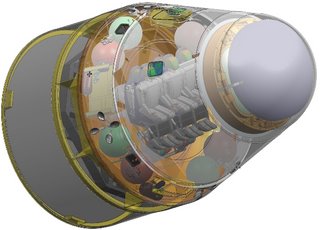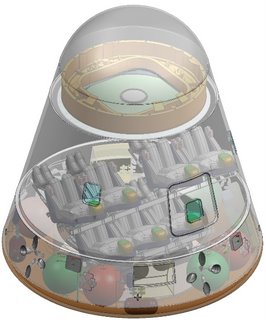Check out this high-quality video of the launch.
Saturday, August 04, 2007
Thursday, August 02, 2007
Unbelievable shots of DemoFlight2
When I saw these, I almost wet my drawers. It's amazing that we see these kinds of photos all the time, but this time for me it was just awe-inspiring. I have actually touched that nozzle. I watched as engineers worked on the finishing touches of the rocket.
And now I see it looking down from outer space. That is just awesome.
So here you go:
Amazing stuff. Digg It!
Demo Flight 2 Review Update Released
Hey everyone.
I know it's been a little while, but there's a great report released by SpaceX on DemoFlight2. You might have already seen it, but in case you didn't, I thought I'd post it to the blog.
Some quick excerpts for the A.D.D. among us:
FAQ
Did the hot-fire abort during the previous launch attempt have any effect on any of the anomalies or observations?
No relationship between the March 19 (PST) abort and the above mentioned anomalies has been found. The engines are designed and tested to be re-started in rapid succession. All vehicle and ground systems showed nominal prior to the decision to attempt launch again.
What caused the abort of the first launch attempt?
Cold fuel caused the combustion chamber pressure to be approximately 0.5% below the engine computer abort limit after engine start. Investigation revealed that the fuel was colder than normal due to the previous day’s launch attempt. Draining back colder than normal fuel into insulated tanks did not allow sufficient time to warm to expected levels for the next day’s operation. The solution is to add warming to the fuel conditioning regimen and verify fuel temp in the T-2 hours launch commit criteria.
And, the conclusion to the report:
This mission represents a large step forward for SpaceX and the Falcon 1 launch vehicle. Although short of complete success, a significant majority of mission objectives were met from both a programmatic and technical perspectives. Open issues were identified, but no items are anticipated to require major re-designs to fix.
Obtaining flight data from the vehicle was the primary objective of this test flight and was clearly achieved based on both the quantity and quality of performance and environmental data. Additionally, concept of operation, procedures, ground systems and control automation systems were validated. A rapid response capability was also demonstrated with a hot-fire abort within 70 minutes of launch.
Stage 1 recovery was not demonstrated and represents the only operational domain from which data was not attained by this mission. Additionally stage 2 coast and Kestrel re-start was not demonstrated, nor was Payload simulator deployment. Eight anomalies were identified which will be addressed prior to the next mission.
--------
For the full report, click here.
Tuesday, March 20, 2007
Hooollllyyyyy Shhiiiiiittttt!!!!
It made it. It's in space. The final frontier!!!
Mofo, that is awesome beyond words.
Will update when I know more.
Here's a sweeeeet photo from the rocket as it left the atmosphere.
Nothing much more to say...
Main Pressure Chamber Abort
Pressure for the Main Chamber was 0.2% under the abort limit.
Missed by a hair...
Attempt will continue after analysis.
Monday, March 19, 2007
T-Minus 8min

Auto-sequence has begun and the strongback has been lowered.
All systems still go.
Falcon 1 on Omelek
For those that don't have access to the webcam, here's a live photo from 1 minute ago.
T-Zero at 4:45pm
As many of you probably know, the launch is in progress as we speak. I've been (painfully) in a car while this has been happening.
The status is that t-zero was moved from 4pm to 4:45pm to examine a data connectivity error between El Segundo (SpaceX head office), and Kwaj.
20 minutes to Ground Zero.
For the live webcam, go to:
http://www.spacex.com/webcast.php
Kimbal
Sunday, March 18, 2007
Static Fire Successful
In preparation for launch of the DemoFlight 2, the team on Kwaj performed a static fire test yesterday. A static fire is when the rocket is fully loaded with fuel, and taken all the way through countdown and then held down as the engines are fired.
The reason for the static fire is to go through the countdown and check all systems. The static fire was successful and proceeded without any aborts. (aborts would be a computer alert to abort the launch based on any small system failure)
Initial review is very positive, almost to the point of a perfect countdown. There was an alert on the GPS system, but it is a back-up system designed to help with accuracy of the rocket's position in space, but not flight-critical.
Regardless, the SpaceX team are examining the GPS thoroughly to understand what caused the alert. Once the scope of the problem is understood, it will determine when the launch will occur.
In the meantime, here is a killer video of the static fire:
http://www.spacex.com/00Graphics/Videos/StaticFire%20HScam1%202007-03-16.wmv
Kimbal
Tuesday, January 16, 2007
Gearing up...
Current status for Falcon 1 is good with the full wet dress rehearsal complete. For those that don't remember what a wet dress rehearsal is, it's when the SpaceX team take the launch vehicle through the full countdown, within one minute of T-zero.
That includes evacuating the launch pad crew off the island, and filling all fuel tanks, taking the vehicle through all checks for launch, up until firing the engines.
It's great news that the wet dress showed only a few non-critical issues.
A static fire is the next step, which is the same as above, but the engines will fire while the rocket is held down. The static fire could happen as soon as Saturday. The reason for the rush is because Kwaj needs to reconfigure for an incoming missile test and the window we've got for the static fire is tight.
I'll keep sending updates as I get them. Once we get close to launch, I'll get everyone the Webcast information. I will post as soon as I have it.
Disclaimer: Nothing has changed and this is still not official SpaceX information. Please refer to the appropriate people at SpaceX for any and all launch information. http://www.spacex.com Digg It!
Thursday, August 24, 2006
A picture says a thousand words...
And each word is cool, cool, cool...
By popular demand, I am posting the photos that SpaceX has released regarding the Nasa COTS project. COTS stands for Commercial Orbital Transportation Services, and is intended to build a replacement for the shuttle to send cargo and people to the space station and beyond.
The project culminates in the delivery of cargo to the ISS in 2009. If that is successful, Nasa can extend the agreement to transport crew members to the ISS.
With that aside, here are the pics:
First of all, SpaceX's transportation vehicle will be a rocket, and not a replica of the shuttle.
The Rocket is the Falcon 9, and it will carry the Dragon Space Ship in its ferring, much the same as in Apollo Program. While it is not a space plane, both Falcon 9 and Dragon are fully reusable, which is a major breakthrough in launch vehicle design.
A 3D viewing of the interior of Dragon, in its cargo-carrying configuration:

How Dragon would be configured to carry crew:
 How Dragon would connect with the International Space Station:
How Dragon would connect with the International Space Station: Dragon docking to the Internation Space Station:
Dragon docking to the Internation Space Station:
Dragon docked to the ISS:

The part of Dragon that carries the cargo and people back to Earth:

The crew configuration for return to Earth:

As I said, cool, cool, cool...
K Digg It!
Friday, August 18, 2006
And the winner is...
What do you do when really crazy good things happen to you. The kind of crazy good things that not only are too good to be true, but in fact are so rare in occurrence that it becomes almost nonsensical.
Like SpaceX getting to build the next Space Shuttle.
Well, you smile. You smile a really goofy, uncontrolled smile.
Like this one:
Seriously though, it is crazy. Here is a company that is barely four years old, but working as hard as they can to make a difference in an industry that was slowly dying from asphyxiation.
And what happens? The government actually considers that a good thing!! Whoa! What happened? I thought the government was supposed to squeeze the last breath out of these sort of efforts.
Turns out that someone different is running the show. Someone that said the way of the past hasn't been as successful as we might like to pretend.
Apparently spending an average of $1.3 Billion per shuttle launch isn't as practical as they once thought. [To be fair, that number is the total money spent on the shuttle program divided by number of shuttles launched, not the marginal cost of each launch - still, that's a lot of pesos]
Un-freaking believable. Congrats to the SpaceX team.

Oh yeah, and if you're wondering when the next launch of Falcon1 will occur, we're targeting before the end of the year.
Later,
K
Disclaimer: Nothing has changed and this is still not official SpaceX information. Please refer to the appropriate people at SpaceX for any and all launch information. http://www.spacex.com Digg It!
Saturday, March 25, 2006
Someone's looking out for that satellite...
The team is on Omelek collecting debris.
The rocket impacted on a dead reef about 250 ft away from the launch pad, so most of it is recoverable for analysis.
Amazingly, the satellite was thrown high into the air when the rocket impacted and came crashing down through the roof of our machine shop, landing mostly intact on the floor! One helluva' return trip.
The hole in the machine shop roof is the only significant damage to the island.
Hi-Res photos of launch
SpaceX has just released photos of the launch showing the fire in the engine.
 Falcon on it's way - guidance showed it on track and headed for a successful trip. Looking closely, a likely fuel leak has resulted in a fire in the engine.
Falcon on it's way - guidance showed it on track and headed for a successful trip. Looking closely, a likely fuel leak has resulted in a fire in the engine.K Digg It!
Post-Launch Analysis
As most of you know by now, the rocket was lost.
From Elon this morning:
"Preliminary Fault Analysis
The good news is that all vehicle systems, including the main engine, thrust vector control, structures, avionics, software, guidance algorithm, etc. were picture perfect. Falcon's trajectory was within 0.2 degrees of nominal during powered flight.
However, at T+25s, a fuel leak of currently unknown origin caused a fire around the top of the main engine that cut into the first stage helium pneumatic system. On high resolution imagery, the fire is clearly visible within seconds after liftoff. Once the pneumatic pressure decayed below a critical value, the spring return safety function of the pre-valves forced them closed, shutting down the main engine at T+29s.
It does not appear as though the first stage insulation played a negative role, nor are any other vehicle anomalies apparent from either the telemetry or imaging. Falcon was executing perfectly on all fronts until fire impaired the first stage pneumatic system.
Our plan at this point is to analyze data and debris to be certain that the above preliminary analysis is correct and then isolate and address all possible causes for the fuel leak. In addition, we will do another ground up systems review of the entire vehicle to flush out any other potential issues.
I cannot predict exactly when the next flight will take place, as that depends on the findings of this investigation and ensuring that our next customer is comfortable that all reasonable steps have been taken to ensure reliability. However, I would hope that the next launch occurs in less than six months.
It is perhaps worth noting that those launch companies that succeeded also took their lumps along the way. A friend of mine wrote to remind me that only 5 of the first 9 Pegasus launches succeeded; 3 of 5 for Ariane; 9 of 20 for Atlas; 9 of 21 for Soyuz; and 9 of 18 for Proton. Having experienced firsthand how hard it is to reach orbit, I have a lot of respect for those that persevered to produce the vehicles that are mainstays of space launch today.
I am very encouraged and grateful that our launch customers took the time to call and express their support of SpaceX when their reaction could easily have been the opposite. We will stand by them as they have stood by us. SpaceX is in this for the long haul and, come hell or high water, we are going to make this work.
As SpaceX is a company that believes in maximum disclosure (within the boundaries of proprietary data and ITAR restrictions), I will try to post as much as possible about this launch attempt over the coming weeks.
--- Elon"
Some photos from the webcam:



















